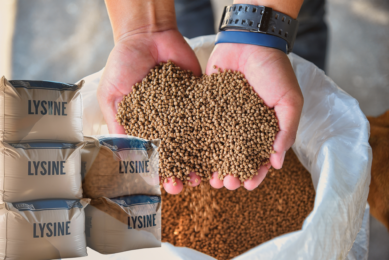Amino acids: Balance is essential
![Piglets are capable of detecting an unbalanced amino acid supply and as such will lower their feed intake. [Photo: Henk Riswick]](https://www.allaboutfeed.net/app/uploads/2020/12/001_938_rb-image-2666279.jpeg)
Behind the addition of amino acids in low crude protein diets for piglets, there is a world of calculations and mathematics. The ?keyword here is balance – if one ingredient is too strongly present, or is missing, feed intake might suddenly just fade away.
A major concern to deal with in piglet nutrition is to feed a high nutrient demanding animal while its feed intake capacity is limited, even more so at the time of the stressful period of weaning. Highly concentrated feeds are therefore used to answer the animal’s needs. However, if a high dietary crude protein feed is given to the piglet, it results in an increased gut pathogenic bacteria proliferation due to the excess of undigested protein and causes severe diarrhoea.
A lower supply of dietary crude protein reduces the global amount of undigested protein in the distal intestine of piglets and results in a better acidification (and digestion) of the bolus. The dietary crude protein reduction solution contributes to a safe start of the pig’s life and should not be done at the expense of the technical and economic performance. The increasing availability of feed grade amino acids has made the further decrease of dietary crude protein possible and changed the way of addressing risk management in piglet feeds.
Feed grade amino acids
With the feed grade amino acids available in the European market it is possible to formulate diets, without minimum constraint on the crude protein level, in which at least seven amino acids are co-limiting:
- lysine (Lys),
- threonine (Thr),
- tryptophan (Trp),
- methionine and cystine (Met+Cys),
- valine (Val) and
- the next limiting amino acid (see also Figure 1).

This next limiting amino determines the resulting dietary crude protein level and can be different in each particular situation as it depends on the feedstuffs locally used and the choice made on dietary amino acid levels.
Indispensable amino acid requirements
From a pool of 20 amino acids, piglets can synthesise all proteins needed to fulfill their maintenance and growth requirements. The 20 amino acids can be considered as essential for the protein synthesis during growth, but nine of them are either not synthesised at all or only in small quantities by pigs. Considered as indispensable in piglets are the six ones summed up earlier, as well as isoleucine (Ile), leucine (Leu), histidine (His), phenylalanine (Phe), and tyrosine (Tyr). This is why they all must be supplied in the diet.
In practice, it is of great importance to ensure that the minimum requirement of each indispensable amino acid is met.
Ideal amino acid profile for practical piglet diets
Ideal amino acid profiles, expressed in ratio to Lysine (Figure 3), are commonly used in practice and based on dose-response trials.
In a recent work from 2015, a team around the researchers Elham Assadi Soumeh and Jan Værum Nørgard (Aarhus University), conducted dose-responses to valine, isoleucine and leucine in young piglets. Requirements values found for average daily gain (ADG) were 71% standard ileal digestibility (SID) Val:Lys, 52% SID Ile:Lys and 94% SID Leu:Lys. Comparing the response to these amino acids (Figure 2), it can be easily understood that in these experiments valine or leucine deficiency is more detrimental to performance than isoleucine deficiency in blood free diets.

Recognising when diets are imbalanced
Amino acids have different impacts on feed intake and it must be considered when low crude protein diets are implemented to avoid amino acid deficiencies or imbalances. Here are a couple of examples.
It has already been demonstrated that tryptophan can stimulate feed intake. Its effect on feed intake is directly linked to tryptophan metabolism and it is advised to maximise levels in young piglet diets to 22% SID Trp:Lys.
The other side of the coin is also possible. Piglets are capable of detecting an unbalanced amino acid supply and as such will lower their feed intake. In a meta-analysis work, a team around Jaap van Milgen, associated with the French National Institute of Agricultural Research (INRA), concluded in 2013 that valine deficiency decreases feed intake to a great extent and consequently gain.
The same observation can be made for isoleucine, but contrary to valine, the response is quadratic and an excess of isoleucine can deteriorate also the feed intake of the piglet. Again the team of Elham Assadi Soumeh very recently also demonstrated a feed intake reduction when leucine is provided below its requirement. Excess leucine was shown not to be detrimental to piglets in her work but dietary valine and isoleucine were strictly controlled which avoided the imbalance and known interaction with leucine.
In 2010, a team led by researcher Mathieu Gloaguen (INRA, Ajinomoto Eurolysine) reported indeed an interaction between valine and leucine: the negative impact of leucine excess on feed intake was much greater in case of a valine deficiency than when valine was supplied at its requirement.
Interpreting a feed intake response
Interpreting a feed intake response is difficult. It cannot easily be determined if the response is due to a nutritional deficiency, a nutritional excess, or an imbalance between amino acids. More research is needed in this field of amino acid interactions, signaling effects and impact on feed intake. From a practical view, providing a low crude protein diet with a balanced amino acid profile is a solution to allow the highest nutrient intake of young piglets.
References available on request.











